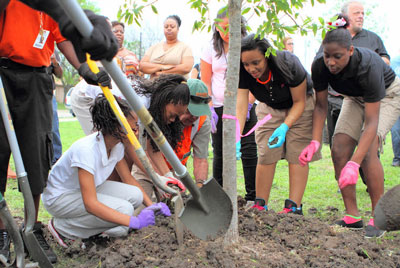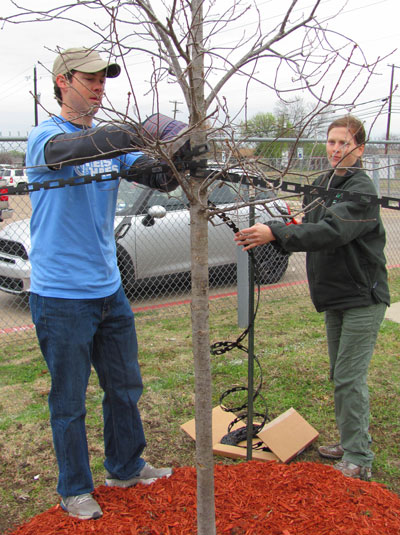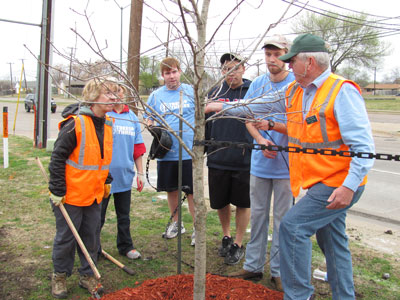Texas Tree Tips: February 2015

Tree planting can be a group activity that, when done correctly, pays benefit dividends for many years. Photos by Sara Beckelman.
by Steve Houser
Tree Planting, Part 4 – Follow-up Care
After a tree is properly planted and watered, follow-up care is required to ensure your investment will provide benefits for years to come. Otherwise, the joy of planting a tree can quickly fade as your tree is transformed into chipper bait.
Newly planted trees must have supplemental water for at least three years or longer in drought conditions. Using a water hose to water by hand is the best watering method, but a soaker hose or drip irrigation can also be efficient. See this earlier article for details. The frequency of watering can vary, based on rainfall and soil type. Clay soils typically hold water longer than sandy soils. Check the moisture content of the soil every two days during the growing season and every four to five days during the dormant season. Newly planted trees will need supplemental water in the dormant season during periods of low rainfall. The idea is to soak the root ball and surrounding soil thoroughly but then to let them dry out near the surface before watering again. When in doubt, check it out.
The only pruning to be done for the first few years is the removal of dead, broken, or damaged limbs. Even if the tree contains poor branching habits in several places, avoid removing green or live limbs until the tree is established and producing healthy tip growth on the ends. Foliage produces food for the tree, and excessive removal can damage a tree’s health. See this earlier article. Any limbs to be removed should be cut with the proper method and at the proper angle.
Although some knowledgeable industry professionals encourage the use of root stimulators, I prefer the use of high-quality nutrient solutions that improve soil environmental conditions and promote the overall health and vigor of a tree. There are growing numbers of products available to fertilize trees or to enhance the soil. However, avoid high-nitrogen fertilizers for the first few years. Any products or mixes utilized should have research to back up the benefits they promote. Mixing a thin layer of finished compost (about a quarter inch) with the mulch also will benefit the soil and help the tree establish itself. Composting creates an environment that benefits earthworms, which ultimately benefit the soil. We should all encourage more global worming.

Proper tree staking will support a newly planted tree until the young root system becomes established.

Be sure to remove any staking once the root system offers adequate support. If you are not sure, gently rock the trunk and watch for soil movement. Once a tree is beginning to establish outward growing roots, the soil will not move very much, and it is time to remove any stakes.
Proper planting and follow-up care protect your investment. Unlike the stock market, trees always pay rich dividends.

